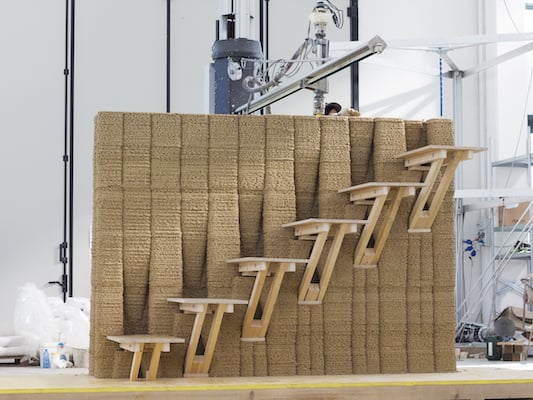The Institute for Advanced Architecture of Catalonia (IAAC) and Italian 3D printing manufacturer WASP Massa Lombarda are collaborating on a project creating load-bearing earthen structures.
The team created an innovative 3D printed wall prototype with an embedded staircase. IAAC Barcelona designed and engineered it and WASP used its Crane printer to bring it to life.
The work is part of IAAC’s Open Thesis Fabrication research (OTF) program which focuses on how additive manufacturing can be used in the construction industry.
Due to its international connections with universities, WASP provides the possibility to use labs and technologies and regularly takes part in interesting architecture lines of research.
3D Printing a Load-Bearing Earthen Wall
Both companies have already worked on creating load-bearing earthen walls. IAAC worked on the Digital Adobe Wall and WASP created Gaia 2, the 3D printed earthen house.
This collaboration builds on both projects and shares the same goal: To create an architectural solution for affordable sustainable housing for, and partially built by, the people.
The prototype wall is 40 cm thick. It has interlocked timber elements which are anchored in the print and provide support for stairs or floor structures.
It took 40 hours to print the wall, which used two cubic meters of material. This material was a mixture of clay and rice fibers which were provided by RiceHouse 3, an Italian startup working on developing a green-building industry.
“In light of results obtained with Gaia and this project, Crane WASP becomes an increasingly useful tool for transferring design logic into real construction models, easily allowing the experimentation of innovative architectural systems and promoting the progress of 3D printing in the construction industry,” said WASP in a press release.
More and more, 3D printing is becoming a viable construction strategy. WASP credits this to the advancement in design methods refined by educational programs such as IAAC’s Open Thesis Fabrication.
On this program, students are trained to become researchers and practitioners on CAD, material engineering and robotic fabrication to foster new design opportunities on bioclimatic architecture.
For more on 3D printing and construction, check out these stories:
- New 3D Printed Houses from Construction Company COBOD International
- The Cogiro Construction Robot Can 3D Print Buildings
- Apis Cor 3D Prints a Small House in 24 Hours for $10,000
Source: Press Release

License: The text of "WASP and IAAC Collaborate to 3D Print Load-Bearing Earthen Staircase" by All3DP is licensed under a Creative Commons Attribution 4.0 International License.